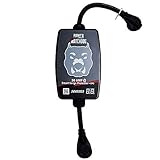If you’ve got a 30-amp RV, knowing how to wire a 30 amp RV plug to replace a broken one can be super helpful. You might think this is an unnecessary skill to master because installing a 30-amp RV plug is best left to the pros. But what if you’re traveling when your RV’s power cord plug gets damaged?
Today we’re covering how to replace a 30 amp RV plug anywhere, anytime, using a few basic tools that you’re (hopefully) carrying on your RV when you travel anyway.
Why You Should Know How to Replace Your RV’s 30-Amp Plug
First off — As always, it’s important to know your comfort and ability levels when tackling any DIY project. That’s especially true with RV electrical and plumbing tasks. Working with electricity (especially 120 volts of AC power vs 12 volts DC), can be intimidating. If you’re not comfortable and proficient, hire a pro.
We recently published a post detailing how to wire a 50 amp RV plug, and there are several reasons why it’s important for 50-amp RV owners to be able to accomplish this important task. We also outlined the installation of a 50-amp RV outlet at home.
It’s equally important, (and maybe even more so than a 50-amp outlet) for owners of 30-amp powered motorhomes and travel trailers to know how to wire an RV 30 amp plug. Here are the three main reasons why it’s so important to know how to correctly replace your 30-amp RV plug:
Damage from Overheating
A 30-amp power plug has two flat current-carrying blades (line and neutral), and one round prong (ground) that carries current only in fault conditions. A 30-amp connection provides 3,600 watts of power (30A x 120V).
A 30-amp RV plug can melt if an RV owner doesn’t pay attention to how much power they’re using and overloads it. Normally, this should trip a circuit breaker, but it can also create excessive heat. Over time, the plug can start to show signs of burning around the blades. This can lead to even more heat and more damage.
This is why it’s important to know what you’re doing when you’re plugged into a 30-amp RV outlet and running various appliances. This gets harder in the summer when the air conditioner is on. Heavy use of the rig’s A/C, combined with corrosion on the blades of the power plug, can cause excess heat that can damage or destroy the plug.
Here’s a video that explains how and why 30-amp RV plugs overheat and melt:
Damage From Use Over Time
The RV plug at the end of your shore power cord gets a lot of use. The same is true of RV park power pedestals. The repeated pushing and pulling of the plug’s prongs into and out of 30-amp outlets can loosen the prongs over time.
It’s also easy to drop the plug onto the ground while handling the heavy cord, which can damage it. So, wear-and-tear issues can compromise your RV’s power plug over time.
Broken Prong
A prong on your 30-amp RV plug can break off. Most often, when this occurs, the prong that breaks is the round one, which is the ground.
Sometimes a weak prong isn’t noticed until you suddenly find it stuck in a 30 amp RV outlet or embedded in your RV surge protector when you pull it out. Those are the most common reasons you’ll need to replace the 30-amp plug on the end of your rig’s power cord.
Fortunately, 30-amp plugs aren’t particularly expensive, so owners of 30-amp rigs might consider keeping an extra on hand in the RV.
Armed with your spare 30-amp RV plug and this post, you’ll be ready to deal with a damaged plug. You’ll be able to cut off the old one, replace it with a new one, and plug your rig into shore power for the rest of your stay.
Any of the above situations will require you to know how to wire a 30 amp RV plug to replace a broken one if a pro isn’t available.
Doesn’t My RV Surge Protector Keep My 30-Amp Plug Safe?
Yes and no. You should absolutely use a high-quality RV surge protector whenever you plug into shore power. We never plug in without our Hughes Power Watchdog.
But while they will offer some protection for your power cord’s plug, it has a much more important job to do — guarding the expensive electrical equipment in your RV. If you run too many appliances at once and overheat your RV power cord’s plug, a surge protector can’t guarantee that that heat won’t damage your plug.
And finally, the repeated inserting and removing of your power cord’s plug can damage it over time, such as the broken ground prong we mentioned above.
While we’re on the topic of surge protection, it bears repeating — we NEVER plug our RV into shore power without using a Power Watchdog. The potential damage to our rig simply isn’t worth the risk.
We think it’s so important that we arranged special RVgeeks discounts on Hughes Power Watchdogs and autoformers so that you can save while protecting your electrical system.
Prices vary, so be sure to check all three sources (factory-direct, Mobile Must Have, and Amazon). Both 50-amp and 30-amp units are available, and we prefer the top models with EPO (Emergency Power Off).
Available factory-direct from Hughes with 10% off:
Make sure your RV is protected from low voltage, bad RV park wiring AND power surges when connecting to shore power with a Power Watchdog and/or Hughes Autoformer. We never hookup without ours (we...Show More
Make sure your RV is protected from low voltage, bad RV park wiring AND power surges when connecting to shore power with a Power Watchdog and/or Hughes Autoformer. We never hookup without ours (we have both), and know our RV's electrical system and all our electronics are being protected.
Watch our Hughes Autoformer video
Watch our Hughes Power Watchdog video
Save 10% on your entire purchase when ordering from Hughes!
Show LessAvailable from Mobile Must Have with 5% off:
Thanks to the latest additions to our RV internet arsenal from MobileMustHave, we're able to stay connected more reliably... and more remotely... than we ever could before. We couldn't be happier...Show More
Thanks to the latest additions to our RV internet arsenal from MobileMustHave, we're able to stay connected more reliably... and more remotely... than we ever could before. We couldn't be happier with the equipment we now have!
Upgrade your RV internet connectivity with great products from Peplink, WeBoost, Parsec, Poynting, Mobile Mark, and more. And while you're there, look at other great products like Viair Compressors!
Watch our video about our RV internet connectivity solutions for 2021
Save 5% on your equipment order at MobileMustHave.com when you click the button on this deal or use discount code "RVGEEKS" at checkout!
Show Less- Replaceable Surge / Spike Module: Should a large spike happen, surge module is completely replacable instead of replacing the entire unit.
- Wirelessly Monitor voltage, amperage, and wattage on your smartphone in real time using our free mobile app! Oldest and most reliable phone app in the...
Tools Needed to Wire a 30-Amp RV Plug
Here are the tools typically needed to complete the DIY replacement of your 30-amp RV power cord’s plug:
- Wire stripper
- Flat blade screwdriver
- Phillips screwdriver
- Utility knife
- Wire cutter
- Marking pen
- Measuring tape
- A replacement 30-amp plug (NEMA TT-30)
How to Wire a 30 Amp RV Plug
Following are the steps to wire a 30-amp RV plug:
- Cut off the old plug as cleanly as possible using a large wire cutter or utility knife.
- Using a utility knife, cut and remove 3″ of the outer casing, being careful not to nick the insulation on the wires inside.
- Cut away all of the interior insulation, leaving only the green, white, and black wires.
- Following the instructions that came with your plug, cut each of the 3 wires to the correct lengths. This will vary for different plugs, but the green (ground) wire will likely be the longest, with the black (hot) and white (neutral) wires shorter.
- Strip back the insulation on all three wires according to the directions that came with your plug.
- Remove the screws holding the head of your new plug together and the screws that secure the cable retention yoke/strain relief.
- Route and connect the ends of the exposed wires to the appropriate blades, tightening them firmly. PRO TIP: You may find it easier to connect the wires if you partially or fully remove the blades from the new plug by pressing them out from the front of the plug toward the back. Also, make sure that the heavy outer casing of the cable will be well held in place by the retaining yoke.
- If you removed the blades, press them back into place inside the plug head, pushing them all the way out through the blade openings, making sure they’re tightly secured in place.
- Install the back cover of the plug and secure it firmly with the screws.
- Place the retaining yoke/strain relief over the outer casing and firmly secure it with the screws. This takes the pressure off the wiring connections rather than having them be responsible for holding the plug and cable together.
PRO TIP: If you’d like to waterproof your new plug, you can add some outdoor-rated silicone to the back of each blade opening inside the plug head, to the base of the plug where the cable and wires enter the head, and under the retaining yoke. Finally, use a thick bead of silicone where the cable meets the retaining yoke.
Once you have your 30-amp plug installed, if you need to adapt down to a 15-amp outlet, or up to a 50-amp outlet, you can watch our video Dog Bones 101.
- REPLACEMENT PLUG WITH HANDLE: Camco's RV Male Plug Replacement lets you attach a standard 30A head to your existing RV extension cord.
- COMPATIBILITY & DIMENSIONS: This plug is compatible with older-style receptacles, ensuring a secure connection. Including the terminals, it measures 4...
- NEMA TT-30P. Rated at 125V 30A, fit's for 10/3 RV cord, replace the male end of 30A RV cord.
- Adopts well-conductive copper pin and flame retardant ABS plastic housing, Inner strain relief clip and outer bushing firmly secure cable, lasting a...
Now you know how to wire a 30 amp RV plug to replace a broken one. For much more on the 30-amp RV plug, see our post entitled, The Complete 30 Amp RV Plug Guide: Your Outlet to Freedom!
Free RVing Tips, Tricks, Reviews, Giveaways & More
Subscribe to our daily newsletter! We’ve been full-time RVers for 20 years (!) and share everything we’ve learned about RVing in our daily blog posts. Join our online community to receive a wealth of great RVing knowledge delivered right to your inbox.
Whether this is your first time on the road or you’re a seasoned full-timer, you’ll love the wide range of RVing topics we cover. Don’t miss a single article or any of our famous RV gear Giveaways — Subscribe today!







LeRay Hinchman
Tuesday 22nd of August 2023
My small RV trailer came with a 30 amp cable that also had an adapter to the regular 20 amp connector which I use when home to keep batteries charged and to use the RV trailer just to relax while at home. I have never had any problems. I am installing an outside outlet for the RV and to use power tools outside. Do I need to install a 30 amp (2 angled pins)? Note, I only occasionally use the RV at home.
TheRVgeeks
Tuesday 29th of August 2023
Hi LeRay... adding a 30-amp outlet would certainly make your trailer even more usable by allowing everything to run (i.e. the air conditioner). But if you don't have any real need for any more power, then adding a 15/20-amp outlet would certainly work, too. Honestly, it would really be your call (and, possibly, budget).
Jeff Stark
Tuesday 1st of August 2023
I had a burnt connector (two actually) last week. How can you have two? Well, 4 years ago I decided to mount my expensive surge guard right in the bay with the power cord. I had the electrician cut the power cord for a new male and a new female in a way so that we can plug the surge connector inside the bay and outside of prying eyes, but when we don't need to worry just plug them right into each other. Why do I tell you all this? Because the new man who fixed it for me told me that one of them had been wired backwards hot/neutral the whole time. (Is that why they fried? Who knows, I mean, it lasted 4 years like that.) So if it was me, I'd suggest to your audience to mark which way the connectors are screwed in before cutting off the whole cord.
And also I'm writing to ask if what the new guy said is even possible. Could all the motorhome functions have worked just fine all that time with that problem?
TheRVgeeks
Tuesday 1st of August 2023
Oh wow, Jeff. Having the hot and neutral wires reversed certainly could have been the issue that caused both connectors to burn out... as the power was flowing the wrong way through the wiring. We'd have to guess that the mis-wiring was on the output of the surge protector (where the RV's wiring connected to the unit). Otherwise, the surge protector should have detected the mis-wiring and not allowed power to pass. Things would've worked... but as you've found out, may have contributed to the issues you've had.